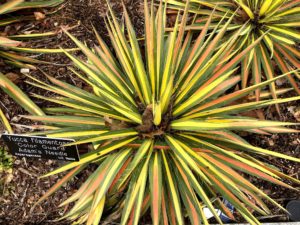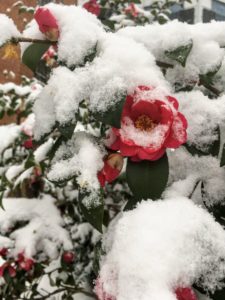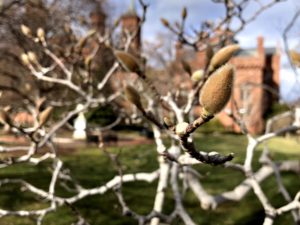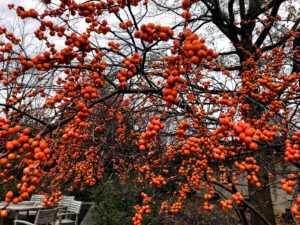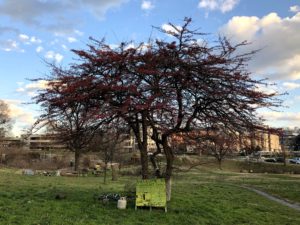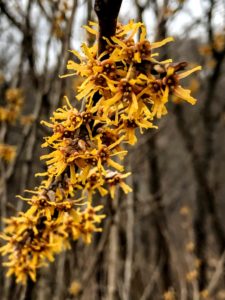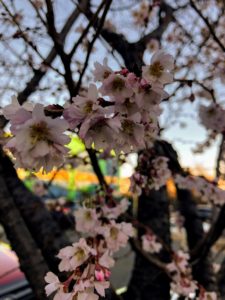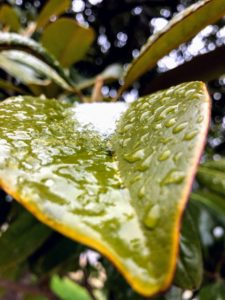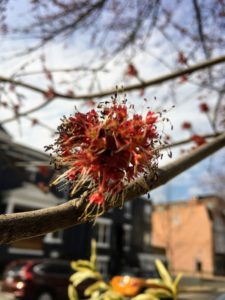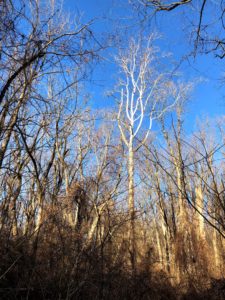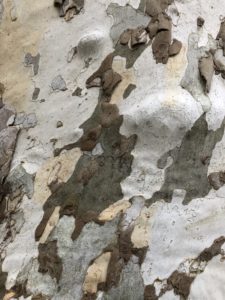THE LEAFLET
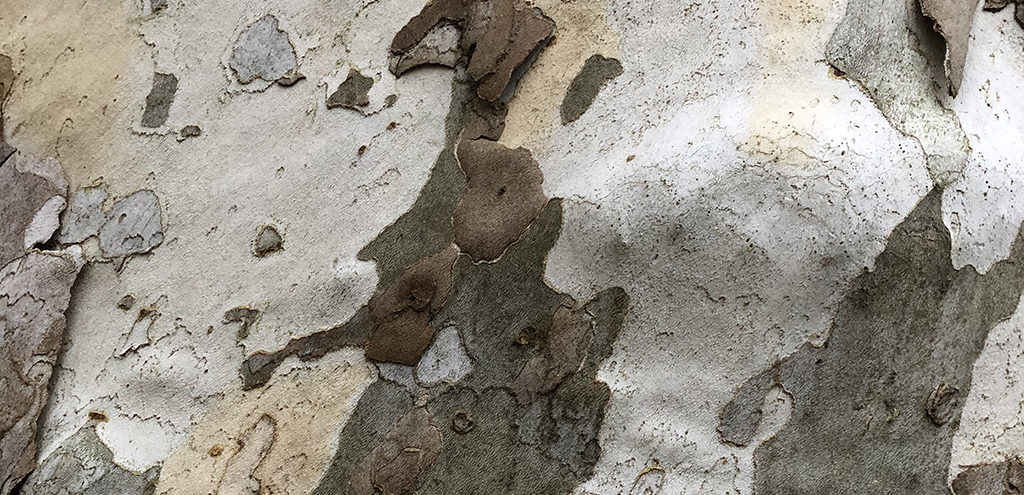
Casey Trees’ Urban Forester Featured in 730DC’s Not a Swamp: Winter Guide
Every season there are fascinating changes occurring in our urban forests, parks, and gardens. Paying attention is the first step toward changing our relationships with the shared natural world. 730DC’s newsletter will help with that! To learn about the wonderful trees of winter and what we had to say about it, check out this feature by Sam Nelson (former crew chief and current Team Leader) and 730DC. All photos by Sam Nelson unless noted.
730DC’s Not a Swamp: Winter Guide
The desire to hibernate through winter is understandable. But winter affords quiet walks, clean looks through leafless forests, and an invitation to study nature’s details in its preparation for spring. Here’s some tips about how and where to look.
Be sure to check out the interview at the end with Cece McCrary of Casey Trees and learn how to get a free in your yard (or how to bug your landlord to get one). Planting trees helps cool houses and neighborhoods while inviting birds and colors. In this edition, every tree with a * is available through the RiverSmart program via Casey Trees and D.C.’s Department of Energy [and the Environment].
Winter Blooms and Colors: Watch for stubborn pansies, Lenten rose or Japanese camellias in green-thumbs’ yards (or in the Asian Collections at National Arboretum). Yucca varieties like ‘Color Guard’ streak bright stripes along sword-ish leaves. Ornamental cabbage or flowering kale, although not edible, are pretty winter substitutes in tree boxes and garden beds. There’s a nice streak of them on New York Avenue NW between 14th and 13th if you need a downtown color lift.
- Yucca (Hirshhorn Sculpture Garden)
- Japanese Camellias (National Arboretum)
- Flowering Kale (M.L. Ripley Garden)
Which Trees to Hug When (Winter Buds, Berries, and Early Blooms): It’s a cold sunless morning, and you’re still in bed. You don’t want to greet the day. So you bundle inside in that warm over-sized comforter and hit the snooze button.
As it turns out, leaves do something similar. New leaves snuggle warmly inside buds and then hit the snoozer for weeks until it’s consistently warm and comfy enough to unfurl. So rather than lament the lack of tree flowers or leaves, take a closer look at these tidy comforters bunching up along branches. Their cozy details and minute changes portend spring. If you’re not down for the wee intimacy of bud-gazing, look for colors in winter berries or early blooms. Here’s what to look for (or feel):
1) Sticky buds. Feel a bud. Is it sticky? That’s resin coating the bud to protect the leaf inside from invading moisture.
2) One of my favorite winter-lookers is Rock Creek’s rockstar, the American beech*. Many leaves just won’t quit and hang on through winter while the tree develops buds simultaneously.
3) Notice a fuzzy bud? Does it feel like a puppy with a fresh cut? It might be a magnolia tree — several varieties have soft, sweater-like buds for their flowers (and smaller buds for leaves) to keep them snug through winter. An exception is the southern magnolia*, a broad-leaf evergreen. Stands of saucer magnolias in the Enid A. Haupt Garden and President’s Park offer good examples.
4) Berries — food for winter birds and eye candy for winter walkers. Check out orange winterberry at the U.S. Botanic Garden’s regional garden; dark-red berries on Chinese pistache (a great example on the corner of Kenyon and Park Pl NW); blue and red berries on viburnum varieties in gardens, yards, and Rock Creek Park; and the Christmas-themed red berries on the evergreen American Holly*.
5) Witch hazel *— an ornamental shrubby tree with scraggly clusters of yellow flowers in winter. They have a sweet and surprising fragrance that my brother says “smell like opening a new CD in the 1990’s.” Common witch hazel is losing its petals about now, but garden varieties are budding in preparation for February blooms or March blooms.
- Viburnum nudum berries (U.S. Botanic Garden)
- Saucer magnolia buds (Enid A. Haupt Garden)
- Winterberry (U.S. Botanic Garden)
- Chinese pistache (Wangari Gardens)
- Witch hazel flowers (Ingleside Terrace NW, north alley)
Tree Spotlight: Is that a cherry blossom in January? Is it the result of climate change? Are we f@#&ing doomed? Maybe. But this mid-winter cherry bloom isn’t an augur of the end of times; it’s natural. There are many flowering cherry varieties in D.C. beyond the attention-greedy Yoshino cherry trees in the Tidal Basin, including the Higan cherry (Prunus subhirtella), sometimes known as the winter-flowering cherry. The ‘Autumnalis’ variety is capable of blooming twice in year, once for the big show in April and then again, with less flare, sometime between November and January. If you’re feeling depressed about the dormancy of color and life amidst the dregs of winter, look for this cherry tree’s unseasonal flowers and take a hint: it’s never too late (or too early) to show up and bloom. Great examples are at American University’s campus arboretum or along 8th street NE across from Dew Drop Inn, although many blossoms are going or gone now.
Native Tree Spotlight: Imagine D.C. as a wilderness and you’re lost in it. Or maybe it’s like The Walking Dead. Either way, you’re lost, thirsty, and without a happy hour. You need water. Look for a ghostly white tree trunk strobing among the browns and grays. This is the wonderful American Sycamore* (Platanus occidentalis). It loves wet areas, lounging along riverbanks and creeks. In all seasons — but winter especially — the upper portions of its trunk appear peeled back in a nearly-effulgent white hue while the lower trunk is an artsy quilt of peeling bark skin. This tree is very similar to London Planetree* (Platanus x acerifolia), a popular urban tree because it’s street tough and sucks up a lot of pollutants from cars while resisting death by road salt. Worth noting: car wheels fling road salt particles great distances — most plants don’t love this. More worth noting: Emmett Till has a memorial tree on the U.S. Capitol’s north lawn, and it’s an American Sycamore, which is also native to the Chicago area.
- Winter-flowering cherry (2800 8th St NE)
- Red maple flowers (Piney Branch Trail)
- Can you spot the wintry white bark of the American Sycamore in Rock Creek Park? (Valley Trail)
- American Sycamore bark
Clockwise from top left: Winter-flowering cherry (2800 8th St NE); Southern Magnolia (President’s Park); Red maple flowers (Piney Branch Trail) ; American Sycamore bark ; Can you spot the wintry white bark of the American Sycamore in Rock Creek Park? (Valley Trail) — Photos by Sam Nelson
Looking Ahead to Spring: Come March, red maples* show the first signs of spring with small clusters of gorgeous red flowers. You got to look close to appreciate them. And they’re a much better judge of the coming spring-light-at-the-end-of-the-winter-tunnel than a dude in a top hat in pretending to translate groundhogese at dawn in the middle of the Pennsylvania woods.
Wildlife Spotlight: Similar to Batman, you will probably never see North American beavers (Castor canadensis) in the district because they mostly work at night (and they’re not abundant here). But look carefully, and you might see their work. Along the C&O Canal, Kenilworth Aquatic Gardens, and even the Tidal Basin, beaver-damaged trees look chewed off in great chunks just off the ground. This has been and off-and-on problem for the Tidal Basin’s cherry trees where NPS sometimes wraps guards around the base of trees to discourage the nocturnal non-hibernating wood-cleaving rodent. In ’99 a beaver managed to fell four trees in the basin before being caught. Last March, a beaver was spotted near the Wharf. Keep a watchful eye out for their woodwork.

Our very own Urban Forester, Cece McCrary
Six Questions with a Local Green Thumb:
Cece McCrary is an Urban Forester with Casey Trees. Her passion for cultivating green spaces in urban environments has aligned her with Casey Trees’ mission to re-tree DC. Currently, Cece works towards helping homeowners plant trees in their own backyards through the city’s RiverSmart Homes program. To learn how to receive a free tree (like the ones * in this guide) from Casey Trees, head here: https://caseytrees.org/plant/residential-planting/
1) What’s cool about your job?
CM: You are never bored. There are a wide variety of tasks associated with being an Urban Forester. I have the chance to interact with the public, whether it’s leading volunteers or consulting with residents about the perfect trees for their homes, while also spending time visiting parks and schools to assess how many trees, and what kind, would best fit those spaces. And finally, working to execute these plans, to see trees in the ground, is such a rewarding experience at the end of it all.
I am also constantly surrounded by people who are as passionate about nature as I am. Nobody tries to change the subject if you want to just talk about plants for 20 minutes.
2) What makes DC’s urban forest and garden scene special?
CM: I’ve been touched and inspired by the passion people in DC have for bettering their communities through tree planting, cultivating and maintaining green spaces in general. Every time I consult a homeowner about planting trees in their garden, I am met with such enthusiasm and desire to understand and learn everything about their tree, how to plant it, why it fits best, and how they contribute to the health and wellness of their surrounding community. The love of nature in this city is both touching and awe-inspiring. My job allows me to witness this passion manifest into positive change at the hands of DC’s citizens.
3) What’s been a favorite book or resource that’s helped you and might help others interest in plants, trees, or green spaces?
CM: One book I love in particular is “Woodland, Wetland, Wildland: A Guide to the Natural Communities of Vermont” by Elizabeth H. Thompson and Eric R. Sorenson. This may sound a bit niche for anyone living in DC, but the observations in this book taught me new ways to look at landscapes. It was a wonderful introduction to understanding the interconnectedness of ecosystems and how to better understand natural communities from a holistic perspective.
In my professional life, I’m often checking out the Morton Arboretum’s website. This arboretum has an incredible amount of data on plant species, which really comes in handy when I come across a tree I’m unfamiliar with.
4) If you could be a plant anywhere in DC, what would you be? Where would you be it?
CM: It’d be fun to be a sage plant in a window box. I would get a pretty nice view and I could be used for savory recipes.
5) How can the city or its residents do better locally to deal with climate change?
CM: Plant more trees! That might be the most predictable thing coming from someone who works for Casey Trees — but it’s true! Trees help offset carbon and stormwater runoff, they provide shade and help combat the urban heat island effect, provide food and shelter for wildlife, beautify neighborhoods…. the list goes on. DC is only bound to get hotter, so let’s give our future generations some shade to sit under.
6) Blow our minds with one plant fact.
CM: Planting even just one tree in an open space can increase bird diversity from zero species to eighty species.
Nature Events:
- Fort to Fort hikes in Rock Creek Park (Feb. 1 & Feb. 8).
- Full moon hikes at National Arboretum (Feb. 8, 9, 10).
- Service Saturday: Clean-up at Carter Barron (Feb. 15) or Malcolm X Park with Washington Parks (Feb. 15, just show up 10 am — 1 pm).
- Lahr Symposium and native plant sale at National Arboretum (March 28th)
- Winter forest bathing walks with Melanie Choukas-Bradley
